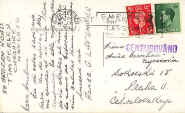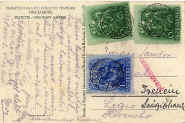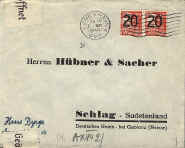Back
Home
Next
Censorship
(Click on the images for
enlargement in a new window)
Before WWII, some of the mail to and from Sudetenland was
censored.
In
February 1935, the Devisen Control law was passed (Reichgesetzblatt 1935, I,
105.)
Under
it, all transactions involving foreign exchange were subject to the
approval
of Devisenstellen (Foreign Control Exchange Office).
With
political intrigue running rampant in Germany
in the 1930's, the inspection of mail for
currency control purposes became an ideal way to "legitimize" the opening of foreign
mail for other purposes. Examples of this "disguised censorship" can be found
sealed with a strip of Currency
Control Examination labels.
|


|


|
|
Registered
cover sent from Leitmeritz
to Liban in Czechoslovakia.
The
cover was censored by the Germans
and sealed with a Currency
Control Examination label.
The
cancel on the label on reverse shows that
it was first sent to
Dresden in
Germany for
examination before it was resent to Czechoslovakia.
|
Cover sent from
Osnabrück to Sonnenberg
in Czechoslovakia.
The
cover was censored by the Germans
and
sealed with a Currency
Control Examination label.
The
cancel on the label on reverse shows that
it was first sent to Chemnitz
in
Germany for
examination before it was resent to Czechoslovakia.
|
The examinations were subsequently made locally in
Sudetenland.


|
|
Cover
sent from Jägerndorf to Prague in
Bohemia and Moravia.
The
cover was censored by the Germans and
sealed with a Currency
Control Examination label.
The
cancel on the label on reverse shows it was
sent to Troppau in
Sudetenland for examination
before it was resent to Czechoslovakia.
|
During
the Sudetenland crisis, Czech military censorship began
on 17 September 1938 and lasted for about two months
for
both international
mail and telegrams, as well as for domestic mail.
The
general censorship of international mail was centralized
with censorship offices in Prague, Brno and Trencin.
Censored
mail was marked "Censurovano" (in chech) and
"Cenzurovane" (in Slovak),
while
confiscated
mail was marked "Zadrzeno".
Censorship
of domestic mail was performed by local military units
where it was found to be necessary.
 |
 |

|
|
Cover
sent from Prague in Czechoslovakia
to Fleurier in
Switzerland.
Censored
in Prague with a "CENSUROVANO" cancel.
|
Registered
cover sent from Karlsbad to
Prague in Czechoslovakia.
Here
it was censored and cancelled with "CENSUROVANO"
|
Cover
sent from Märish Schönberg to Brno
in
Czechoslovakia.
Here
it was confiscated and cancelled with a boxed "Zadrzeno".
|
 |
 |
 |
|
Uprated
postal card sent from Znaim to Brno in Czechoslovakia.
Here
it was censored and cancelled with a boxed "CENSUROVANO".
|
Commercial
card sent from Haida to
Bratislava
in Czechoslovakia.
It was censored
in Trencin and
cancelled with a "CENSUROVANE".
|
Postal card sent from
Levoca - Spisska
Nova
Ves to Frenstat Pod Radhostem
both
in Czechoslovakia.
It was censored
localy and cancelled
with a "CENSUROVANO".
|
 |
 |
 |
|
Registered
cover sent from Asuncion
in Paraguay to Prague in
Czechoslovakia.
Censored
in Prague with a "CENSUROVANO" cancel.
|
Commercial
cover sent from Beyrouth in Lebanon to Prague in Czechoslovakia.
It
was censored
in Prague with a "CENSUROVANO" cancel.
|
Post
card send from Prerov to a soldier stationed in Olomouc, both in
Czechoslovakia.
It was censored localy in Prerov and
cancelled with a "CENSUROVANO".
|
 |
 |
 |
|
Post card sent from
Paris in France
to
Nachod in Czechoslovakia.
It was censored
in Prague and
cancelled with a "CENSUROVANO".
|
Post card sent from
Manchester in
Great
Britain to Prague in
Czechoslovakia.
Here
it was censored and
cancelled with a "CENSUROVANO".
|
Post card sent from
Tatarszentgyörgy in
Hungary
to Trencin in Czechoslovakia.
It was censored
localy and
cancelled with a
"CENSUROVANE".
|
Czechoslovakia
were not the only country to have temporary censorship
during
the Sudetenland crisis.
Other
countries did as well.
 |
 |
|
Air
Mail cover sent from Capetown in
South Africa to Prague in Czechoslovakia.
It
was first censored, in transit, by the
Greeks in Athens and
later by the Czechs in Prag.
The
circular cancel is the Greek censor
cancel and the one line the Czech.
|
Commercial
cover sent from
Karlsbad to Sofia in Bulgaria.
Here
it was censored by the Bulgarians
and cancelled with a circular cancel.
|
With
the start of WWII, all
mail sent abroad was censored.
The
mail was now censored in different cities, depending upon to
which
country it was sent.
|

|

|

|
|
Postal
card sent from Sternberg to
Banovce
n/Bebr.
in Slovakia.
Censored
in Vienna.
|
Registered
Postal card sent from Bucarest
in Rumania
to
Reichenberg in Sudetenland.
First
censored in Bucarest by the Rumanian later in Vienna by the German.
|
Special
Delivery Postal
card sent from
Mährisch
Trübau to Torino in Italy.
Censored
in Munich
|
|

|

|

|
|
Express
cover sent from Kaaden to
Monte Carlo in Monaco.
Censored
in Vienna.
|
Newspaper
wrapper sent from Asch to Amsterdam in Holland.
Censored
in Köln.
|
Air
mail cover sent from Eger to
Red
Cross Geneva in Switzerland.
Censored
in Munich.
|
|


|


|


|
|
Commercial
cover sent from Galtenhof
über Tachau to Copenhagen in Denmark.
Censored
in Hamburg.
|
Commercial
cover sent from Graslitz
to Budapest in Hungary.
The
sender was trying to avoid
censorship
by referring to an
exemption
that the firm
used for censorship of their telegrams sent
abroad,
"Zum
Ausland-Telegram-Verkehr zugelassen laut Erlass vom 15.12.1939"
However,
it didn't work as planned and
the cover was censored in Vienna.
|
Cover
sent from Halbstadt to Hilliard
in
the USA.
Censored by the Germans in Berlin and
later in transit censored by the
Italians.
|
|


|


|


|
|
Cover
sent from Copenhagen in Denmark
to Schlag in Sudetenland.
Censored
in Berlin.
|
Registered
Air Mail cover sent from
Reichenberg
to Istanbul in Turkey.
Censored
in Vienna.
|
Registered
cover sent from Gablonz
an
der Neisse to Geneva in Switzerland.
Censored
in Munich.
|
Home
Back
Next


































